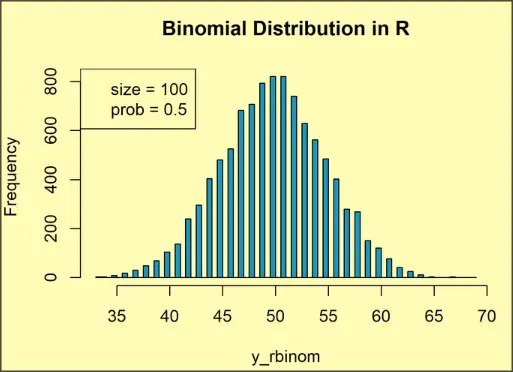A Discrete Distribution used to model Independent Bernoulli Trials .
Uses Binomial Theorem in tandem with probabilities to get our probability distributions.

Probability in a Binomial Distribution
- p is the probability of success on any individual trial. (eg. 50% a coin toss)
- q = 1 - p
- n = number of trials
- P total number of trials
- x = result
Expectation Formula
Examples
Example 1
heads probability 50%, tails probability 50%. probability distribution of flipping 3 times Note that h + t = 1. 100% divided up into probability sets
Solution
= (1/8) + (3/8) + (3/8) + (1/8) first term is P(no tails), P(no tails) = 1/8 P(one tail) = 2nd term. P(one tails) = 3/8 P(second tail) = 3rd term. P(second tails) = 3/8 P(third tail) = 1/8
Example 2
Flip a coin 4 times. GIve the probability distribution where ‘T’ is the successful outcome T = the number of Tails. What is the expected number of ‘T’s?
| T = t | P(T = 1) |
|---|---|
| 0 | 1/16 |
| 1 | = |
| 2 | = |
| 3 | 4/16 |
| 4 | 1/16 |
| This follows pascal triangle you see! If you add up all the probabilities, they should equal 1. | |
| 1/16 + 4/16 + 6/16 + 4/16 + 1/16 = 16/16 = 1! | |
| The expected number is 2. |
Example 3
Game consists of rolling a pair of dice 10 times. for each sum that equals 6,7,8 or 2, you win 1 dollar. it costs 5 dollars to play the game. Is this a fair game?
Solution
n = 10 p = … cases for 7 : {(1,6),(2,5),(3,4),(4,3),(5,2),(6,1)} = 6 cases cases for 6 : {(1,5),(2,4),(3,3),(4,2),(5,1)} = 5 cases cases for 8 : {(2,6),(3,5),(4,4),(5,3),{6,2}} = 5 cases 6 + 5 + 5 total possibilities = 6^2 = 36 p = 16/36
E(X) = np = 10 (4/9) = 40/9 = 4.44
4.44 is smaller than 5 dollar. not fair!